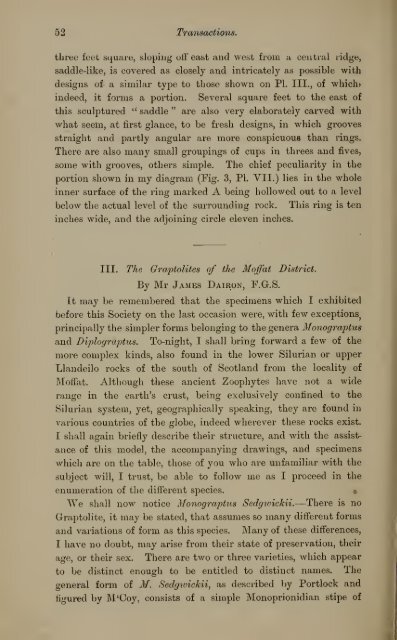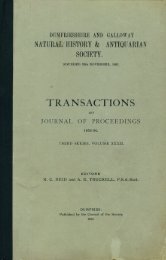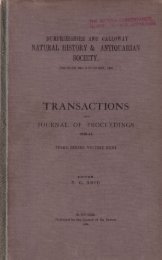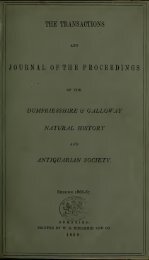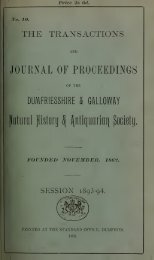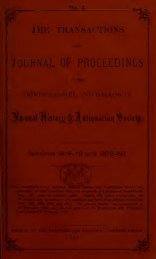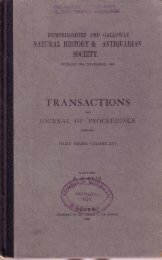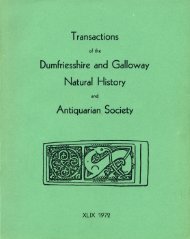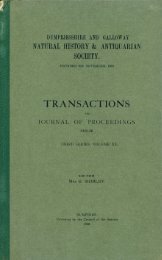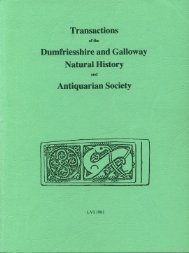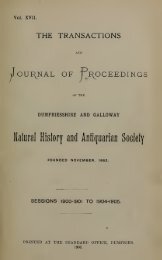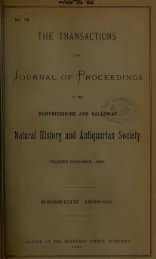52 Transactions.three feet square, sloping oflF east <strong>and</strong> west from a central ridge,saddle-like, is covered as closely <strong>and</strong> intricately as possible withdesigns of a similar type to those shown on PI. III., of which)indeed, it forms a portion. Several square feet to the east ofthis sculptured " saddle " are also very elaborately carved withwhat seeln, at first glance, to be fresh designs, in which groovesstraight <strong>and</strong> partly angular are more conspicuous than I'ings.There are also many small groupings of cups in threes <strong>and</strong> fives,some with grooves, others simple. The chief peculiarity in theportion shown in my diagram (Fig. 3, PI. VII.) lies in the wholeinner surface of the ring marked A being hollowed out to a levelbelow the actual level of the suri'ouuding rock. This ring is teninches wide, <strong>and</strong> the adjoining circle eleven inches.III. The Graptolites of the Moffat District.By Mr James Daieon,F.G.S.It may be remembered that the specimens which I exhibitedbefore this Society on the last occasion were, with few exceptions^principally the simpler forms belonging to the genera Monograptus<strong>and</strong> Diployraptus. To-night, I shall bring forward a few of themore complex kinds, also found in the lower Silurian or upperLl<strong>and</strong>eilo rocks of the south of Scotl<strong>and</strong> from the locality ofMofiiit. Although these ancient Zoophytes have not a widerange in the earth's crust, being exclusively confined to theSilurian system, yet, geographically speaking, they are found invarious countries of the globe, indeed wherever these rocks exist.I shall again briefly describe their structure, <strong>and</strong> with theassistanceof this model, the accompanying drawings, <strong>and</strong> specimenswhich are on the table, those of you who are unfamiliar with thesubject will, I trust, be able to follow me as I proceed in theenumeratio]! of the diflerent species. «AVe shall now notice Monograptus Sedgwickii.—There is nomay be stated, that assumes so many diff'erent formsGi-aptolite, it<strong>and</strong> variations of form as this species.Many of these differences,I have no doubt, may arise from their state of preservation, theirage, or their sex. There are two or three varieties, which appearto be distinct enough to be entitled to distinct names. Thegeneral form of M. Sedgwickii, as described by Portlock <strong>and</strong>figured by M'Coy, consists of a simple Monoprionidian stipe of
Transactions. 53considerable length. The breadth of the adult portion of thestipe from the solid axis to the cell mouth is from one to twolines. The axis is capillary, the common canal is broad, sometimesattaining a width of .^V^li of an inch. The cellules arelong, slender, <strong>and</strong> pointed, their superior margins slightly convex,<strong>and</strong> having a general direction at right angles to the axis ;theirinferior margin more extensively curved, the inner or liasal portionbeing sharply inclined to the axis, while the outer half isnearly horizontal.Each cellule is of a triangular shape, the baseresting on the common canal, the cell apertures being at theapex. The cellules are separate, from 20 to 24 in the inch, theirgeneral inclination being slightly upwards, nearly at right anglesto the axis.Locality—Dobb's Linn, Garpel Glen, &c.Monograptus Sedgivickii, var. triangidatus.—This is a wellmarked variety of M. Sedgivickii, <strong>and</strong> not a distinct species. Thestipe is simple <strong>and</strong> moniprionidian, <strong>and</strong> is more or less curved)beginning with a small radical <strong>and</strong> a slender curved proximalportion, which gradually straightens as it reaches full development.The axis is capillary ; the common canal is slender, <strong>and</strong>very much narrower than in the normal form. The cellules arefrom 20 to 30 in an inch, nearly at right angles to the axis, <strong>and</strong>sometimes approaching the appearance of a Rastrite so nearly as.to be mistaken for such.Locality—Dobb's Linn <strong>and</strong> Beld Craig.MonograjHus lohiferus (M'Coy).—In this species the stipe islinear, monoprionidian, often of great length. The full grownindividual reaches a breadth of one-tenth to one-twelfth of aninch. The axis is slender. The common canal is rather broad <strong>and</strong>well marked. Cellules are nearly at right angles with the axis,but having a slight upward inclination. Their upper margin iscurved, terminating in obtusely rounded lobes, inwhich a notchon the under side separates the rounded extremity from theoblique descending margin (M'Coy). The cellules in full grownspecimens vary from 16 to 18 in the space of an inch. The baseisslender <strong>and</strong> curved, the common canal having a comparativelygreater width. The cell, as is occasionally well shewn, opens atthe notch in the under side of the cellule. Locality—Dobb'sLinn, Beld Ci-aig, &c.Climacograptus teretiiisculus.—This genus was at first describedby Professor M'Coy, <strong>and</strong> named by him Di2}lograptus rectangularis.It is very al)undant, having a wide range passing up through theSkiddaw States, Lower <strong>and</strong> Upper Ll<strong>and</strong>eilo, Caradoc, <strong>and</strong> Lower
- Page 1:
THE TRANSACTIONS•^^g^feJOURNAL OF
- Page 4 and 5:
—" How charming is Divine Philoso
- Page 6 and 7:
——————CONTENTSPaficSecr
- Page 8 and 9:
I2 Transactions.crops in the old wo
- Page 10 and 11:
4 Transactions.Glasgow Geological S
- Page 12 and 13:
—Transactions.5th November, 1886.
- Page 14 and 15:
I8 Transactions.and is very irregul
- Page 16 and 17:
\10 Tronmrtiotis.jig ; H. cracatum
- Page 18 and 19:
12 Transactions.the rebellion of 17
- Page 20 and 21:
..14 Transactions.Society were acco
- Page 22 and 23:
61Trani^nctionH.constantly in motio
- Page 24 and 25: 8;1Transactions." Meteorology," in
- Page 26 and 27: —20 Tra/HsactioHS.Provost or Alde
- Page 28 and 29: 22 Traitsactions.Scotland, as in th
- Page 30 and 31: —24 Transactions.the Lower orWlii
- Page 32 and 33: 26 Transactions.long supported and
- Page 34 and 35: Languendo,—28 Transactions.Uh Mar
- Page 36 and 37: DeiMag30 l^ranadtctiond.wood, shape
- Page 38 and 39: 32 Transactions.in the sea for the
- Page 40 and 41: 34 Transactions.a good deal here. I
- Page 42 and 43: 36 Tran.sactions.not run by day, bu
- Page 44 and 45: ;38 Transactions.\st April, 1887.Dr
- Page 46 and 47: 40 Transnctio7is.guessed it to be o
- Page 49 and 50: —Transactions. 41ancient British
- Page 51 and 52: —Transactions.'43as the Milton Pa
- Page 53 and 54: IWansactions. 46one I have noticed
- Page 55 and 56: —Transactions 47Some two hundred
- Page 57 and 58: •~?lATt. 1 =^YPr 1.© © ©€* e
- Page 59: Tlats H .HOMPSON ,S;^TONE'Photo -Ti
- Page 63: -RZZ-TlATX- IT.^T••MiGH BRINKSS
- Page 67: TiATE^ITHt: CiAcHANliOLU STONE(BOBG
- Page 71 and 72: —Trannactions. 49type.But its fel
- Page 73: Transactioiis. 51portion which is d
- Page 77 and 78: —TransartionR. 55The genus Didymo
- Page 79 and 80: Transactions. 57while Mr Carruthers
- Page 81 and 82: Field Meetings.59From the churchyar
- Page 83 and 84: Field Meetings. 61was obtained. lu
- Page 85 and 86: —Field ^feetin
- Page 87 and 88: —Field Meetings.'65levying; duos.
- Page 89 and 90: Field Meeting8. 67ings in the neigh
- Page 91 and 92: Appendix.G'JNATURAL HISTORY DIVISIO
- Page 93 and 94: —Apprndix. 71smaller birds— by
- Page 95 and 96: wlio was an honorary burgess of the
- Page 97 and 98: — —Appr.ndix. 75—R. B."Table,
- Page 99 and 100: Appendix. 77James Litiljohne, &c.,
- Page 101 and 102: ——;Appevi/ix. 79Manuscripts.
- Page 103 and 104: —"——Appendii: 81Thomas Huttou
- Page 105 and 106: ——— ——————Appendi
- Page 107 and 108: APPENDIX B.LIST OF MEMBERS OF THE S
- Page 109 and 110: ,,,5th Nov.,3d Fel>y.,5th July,•2


